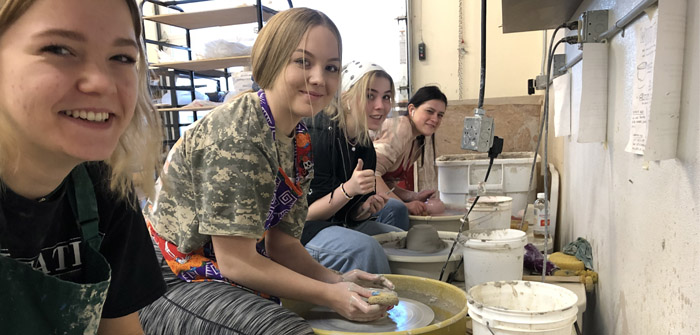(Redmond Proficiency Academy Ceramics Students | Photo Courtesy of RPA)
Redmond Proficiency Academy’s (RPA) ceramics instructor, Ethan Stelzer, has been able to take his high school January class deeper into the art form due to RPA’s intensive three-week course of study called Jan Term.
Running from January 6 to January 23, 2020, Jan Term was created to allow students to explore a subject they would not otherwise take during a regular grading period, and to allow other students to gain more in-depth experience in a subject with which they are already familiar.
“I really enjoy Jan Term because you have more time to practice and learn about a certain subject and have fun with it, which is more enjoyable,” sophomore Olivia Turner said. “I’ve been able to learn about pottery, how to center the clay as well as the different glazes, and all the different techniques.”
For the past couple of weeks, Stelzer’s students have been working on formulating glazes and experimenting with hand-dug clays. Before the end of the term, students will take on some alternative firing styles called raku, barrel firing and reduction firing.
Raku is a traditional Japanese-inspired firing process where white-hot pieces are removed from the kiln and quenched in organic materials; while they are still hot, pieces are covered, which creates a strong oxygen reduction that causes changes in glazes and clay bodies.
Barrel firing is another non-conventional method to achieve color and texture. Pottery is stacked in a barrel with wood below, and as the fuel burns, the smoke and ash create a carbon-rich environment that allows the pottery to absorb the smoke and flames.
Reduction firing is conducted in a gas or other fuel-burning kiln. This method is used to obtain rich, earthy colors with iron from the clay often showing through, giving a speckled appearance.
Students are also learning about the chemistry of glazes, experimenting to create their own formulas with specific colors and textures from compounds and minerals like silica, cobalt oxide and kaolin. They have to balance the amount of silica with enough flux, alumina and colorants to cause the glaze to melt and turn glassy at the exact right temperature and still achieve the desired color.
“I’ve really enjoyed focusing on one class for the entire day,” junior Erin Wanamaker said. “You can definitely tell you have a deeper, more complex understanding of the material, more than if you were in the class for only a couple of hours a week.”

